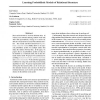Free Online Productivity Tools
i2Speak
i2Symbol
i2OCR
iTex2Img
iWeb2Print
iWeb2Shot
i2Type
iPdf2Split
iPdf2Merge
i2Bopomofo
i2Arabic
i2Style
i2Image
i2PDF
iLatex2Rtf
Sci2ools
124
click to vote
ICML
2001
IEEE
2001
IEEE
Learning Probabilistic Models of Relational Structure
Most real-world data is stored in relational form. In contrast, most statistical learning methods work with "flat" data representations, forcing us to convert our data into a form that loses much of the relational structure. The recently introduced framework of probabilistic relational models (PRMs) allows us to represent probabilistic models over multiple entities that utilize the relations between them. In this paper, we propose the use of probabilistic models not only for the attributes in a relational model, but for the relational structure itself. We propose two mechanisms for modeling structural uncertainty: reference uncertainty and existence uncertainty. We describe the appropriate conditions for using each model and present learning algorithms for each. We present experimental results showing that the learned models can be used to predict relational structure and, moreover, the observed relational structure can be used to provide better predictions for the attribute...
ICML 2001 | Machine Learning | Observed Relational Structure | Probabilistic Relational Models | Relational Structure |
Related Content
| Added | 17 Nov 2009 |
| Updated | 17 Nov 2009 |
| Type | Conference |
| Year | 2001 |
| Where | ICML |
| Authors | Lise Getoor, Nir Friedman, Daphne Koller, Benjamin Taskar |
Comments (0)

